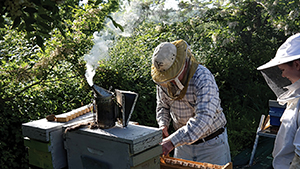Archived Columns
Leveraging Hormones to Fight the Mite

A pupa is more than just a food source for varroa — it supplies the mite with vital hormones. And when the supply is cut off, the mite can no longer reproduce.
Hormones control everything from our mood to our sex drive, sleep patterns, and hunger. Without these chemical messengers, our day-to-day lives would be fundamentally altered: Think, for example, of life after menopause, when the female sex hormones (estrogen and progesterone) plummet. This drop in just two of the approximately fifty different hormones that dictate our lives comes with weight gain, hot flashes, changes in mood, and increased risk of diseases like osteoporosis and breast cancer. Like most animals, we regulate our own hormones; that is, our cells produce and degrade our own hormones as needed. But not every animal is so lucky.
Varroa is one of the unlucky ones. The mites need hormones too, but they can’t synthesize everything they need. Instead, varroa is entirely dependent on honey bee pupae to supply it with one hormone, ecdysone, which it needs to initiate oviposition. Eons ago, varroa lost the ability to make its own ecdysone — the mite’s genome is missing some of the key genes it would need for ecdysone biosynthesis — despite it being essential for the mite’s own reproduction. Without it, a foundress can still invade a honey bee brood cell, but can’t lay eggs and start a family.
Last year, Dr. Benjamin Conlon and his colleagues at the Martin-Luther-University, Germany, discovered that mutations in some honey bee genes are tightly linked to innate resistance to varroa.1 The genes (phantom and cyp18a1) are involved in regulating ecdysone production and degradation. The idea is that by cutting off or disrupting the supply of ecdysone, the honey bee brood can suppress mite reproduction, and this helps keep the mite population from growing out of control. Last spring, the authors published a new study in Molecular Ecology describing mutations in a third ecdysone-linked honey bee gene (mblk-1) that is also linked to innate resistance to varroa.2 “We identified a different genetic basis for the same trait in two independently evolved populations of varroa-resistant honey bees,” says Conlon. And it looks like these traits could share the same physiological pathway. “This shows the power of natural selection to develop different solutions to the same problem.”
The researchers began their study by investigating the genetics of a single colony with a specific pedigree. Starting with a queen who was the daughter of a naturally selected, varroa-resistant queen from Gotland Island, Sweden, they instrumentally mated her with a single drone from a varroa-susceptible colony. Half the genes of her progeny would therefore come from the varroa-resistant colony, and the other half from a varroa-susceptible colony. Conlon and his colleagues then used her to re-queen a varroa-riddled hive, and waited for her to lay drones.
Drones are especially useful in honey bee genetics studies because they have only one set of chromosomes and no fathers. Their genotype is therefore entirely dictated by which set of chromosomes they get from the queen. So in this case, approximately half the drones should exhibit the resistance gene(s). In the first study, Conlon and his colleagues painstakingly uncapped hundreds of drone cells, looking for those that contained a foundress mite but no offspring, despite having had ample time to start laying eggs (the ‘resistant’ drones). They sequenced the genomes of 40 such drones and 40 that had bustling mite families (the ‘susceptible’ drones) to look for the genetic basis of suppressing mite reproduction. In their second study, they used a similar approach but using an unrelated varroa resistant colony (from Toulouse, France) and more advanced genome sequencing technology.
Both of these studies showed that ecdysone-linked genes underlie varroa resistance. Normally, after a would-be mother mite invades a brood cell, she begins to feed on the brood, ingesting ecdysone along with other nutrients and proteins from the bee. The brood is her sole source of ecdysone, and soon after feeding she starts synthesizing yolk proteins (vitellogenin), her ovaries activate, and she begins laying eggs. But in these two colonies from genetically distinct populations, Conlon et al. found ….


